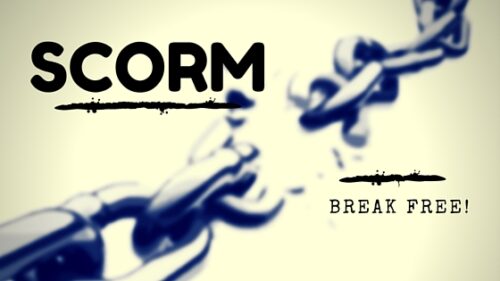Free Your Training Content from the Chains of SCORM
If you’ve been in the eLearning industry for any significant period of time you know the industry thorn that is SCORM. It was a wonderful idea at the time. It was created by smart people with the best of intentions. However, it’s safe to say that the SCORM format has not stood the test of time. The internet, on the other hand, has managed to stay flexible, malleable, and powerful. Other systems locking users into a proprietary content “packaging” system have long since disappeared. Systems like the RealPlayer format are dead and gone. Flash is dead but lingers on as a zombie in certain parts of the internet. Only a few media standards have managed to win the hearts and minds of internet creators around the world. The winners seem to be the ones that play nicely with the HTML5 standard. But SCORM is not one of them.
Text, Audio, or Video – It’s That Simple
Text, audio, and video are the media that rule digital world. There is no reason why the training industry needs a content delivery standard when the internet has perfectly acceptable standards. As long as you use text, audio, and video in formats accepted by the mainstream internet your content will work…on any device that can access the internet. There was a time, when the internet was just a baby, new formats were being created regularly by every new internet startup. Lack of interoperability forced our industry (actually the US military) to demand that a standard for eLearning be created. The expectation was that all eLearning course packages would be playable on every different LMS, and computer system in use at the time. But that was before the cloud and HTML5.
The Cloud Makes Everything Digital Better
Cloud computing changed everything making systems like Salesforce.com, and learning management systems like Litmos, possible. I’m not an expert in cloud computing, but I do know that standard internet media formats work perfectly across all the cloud-based systems I use. Text is supported as .txt as well as html and others. Audio files play perfectly as .mp3 or .wav. And video formats like .mov and .mp4 just work. And yes, I know there are many many more formats. And that fact alone might have you questioning my purpose for this post. The real defining element comes from browser compatibility. Understanding what formats are supported by the most browsers will give you the best options for reaching the largest audience. Corporate training used to rely on their IT departments to maintain computing standards across all machines, but the bring-your-own-device trend is changing all of that.
Back when training content was only packaged as courses it made sense that all self-paced online content would be based on the course package as well. So, early LMSs were designed around courses being uploaded as one package. This meant creating that course package in an authoring tool outside of the LMS. Cloud-based LMSs have changed all that. Litmos gives you the best of both worlds. You can upload pre-packaged courses or create courses without SCORM from inside the LMS. If you absolutely must, there is a SCORM module that will manage your SCORM course upload. But there is also a collection of other modules supporting other media types, and even built-in interactive assessment types and survey modules. Despite being SCORM friendly, Litmos also gives you the opportunity to move away from the complexities of the standard.
Leaving SCORM is Easy
Moving away from SCORM will no doubt upset the large market built around it’s existence. But the writing is on the wall, and has been for a while now. Moving learning content to native media formats and HTML5 will eliminate many headaches you are no doubt feeling due to SCORM. It’s time to unpack your media content from the confines of the SCORM package. Just think about how you use the internet on a daily basis. Does it feel anything like the SCORM experience you put your learners through. If your learners wanted to review just one part of your SCORM course again would it be possible without relaunching the entire course? Your learners are using the internet for almost every part of their lives. And those interactions work in a very specific way. Giving them an experience that feels old and inflexible will not gain supporters for your training efforts. However creating learning content that looks and functions like normal internet content will eliminate that layer of complexity that intrudes upon the learning process.
With Litmos it’s easy to create training courses using media formats already supported by the internet and familiar to your learners. Start a FREE trial today and find out for yourself.






